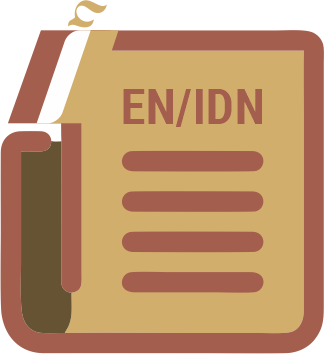TANAWWU’ AL-LAKSIMAT AL-‘ARABIYYAT SLANK: DIRASAT HALAT ‘AN AL-LAHJAT AL-‘ARABIYYAT AL-SU’UDIYYAT WA AL-LAHJAT AL-‘ARABIYYAT AL-MISHRIYYAT
Abstract
Full Text:
PDFReferences
Al Khuli, M. A. (1982). A. Dictionary of Theoretical Linguistict: English-Arabic with an Arabic-English glossary. Beirut: Librairie du Liban
Al Shamsi, A. A., & Abdallah, S. (2022). A Systematic Review for Sentiment Analysis of Arabic Dialect Texts Researches. Lecture Notes in Networks and Systems. 291-309. DOI: https://doi.org/10.1007/978-3-030-85990-9_25
Alsudais, A., Alotaibi, W., & Alomary, F. (2022). Similarities between Arabic dialects: Investigating geographical proximity. Information Processing and Management, 59(1). DOI: https://doi.org/10.1016/j.ipm.2021.102770
Bouamor, H., Habash, N., Salameh, M., Zaghouani, W., Rambow, O., Abdulrahim, D., Obeid, O., Khalifa, S., Eryani, F., Erdmann, A., & Oflazer, K. (2019). The Madar Arabic Dialect Corpus and Lexicon. LREC 2018 - 11th International Conference on Language Resources and Evaluation, 3387-3396
Chambers, J. K. C., & Trudgill, P. (2012). Dialectology. Cambridge: Cambridge University Press. DOI: https://doi.org/10.1017/CBO9780511805103
Harrat, S., Meftouh, K., & Smaili, K. (2019). Machine Translation for Arabic Dialects (Survey). Information Processing and Management, 56(2), 262-273, DOI: https://doi.org/10.1016/j.ipm.2017.08.003
Ismail, A. S. (2003). Mengenal Dialek-Dialek Bahasa Arab. Al Qalam, 20(98), 41–50.
Nandang, Ade, Q. A. (2018). Pengantar Linguistik Arab. Bandung: PT. Remaja Rosdakarya.
Ni’mah, U. N. (2009). Bahasa Arab sebagai Bahasa Diglosis. Adabiyyat, 8(1), 29-48. DOI: https://doi.org/10.14421/ajbs.2009.08102
Paramarta, B. P. (2018). Analisis Korpus Terhadap Idiom Bahasa Indonesia yang Berbasis Nama Binatang. Lingua, XIV(024), 18–25. DOI: https://doi.org/10.15294/lingua.v14i1.12903
Robins, R. . (1992). Linguistik Umum Sebuah Pengantar. Yogyakarta: Kanisius.
Sellami, Z. (2022). The Typology of Progressive Constructions in Arabic Dialects. STUF - Language Typology and Universals, 75(4), 555-582. DOI: https://doi.org/10.1515/stuf-2022-1063
Setiyadi, A. C. (2011). Dialek Bahasa Arab Tinjauan Dialektologis. At-Ta’dib, 6(1), 127-146 https://doi.org/10.21111/at-tadib.v6i1.552
Sumarsono, & Paina, P. (2002). Sosiolinguistik. Yogyakarta: SABDA (Lembaga Studi Agama, Budaya dan Perdamaian)
Suparno, D. (2018). Refleksi Variasi Fonologis Pada Fonem. Arabiyat : Jurnal Pendidikan Bahasa Arab dan Kebahasaaraban, 5(2), 214–232. DOI: https://doi.org/10.15408/a.v5i2.7035
Wafi, ‘A. A. W. (2015). Fiqh Al-Lughah. Cairo: Daar Nahdhah Mashr li Al-Nasyr
Wahya. (2010). Mengenal Sekilas Dialektologi Kajian Interdisiplinier tentang Variasi dan Perubahan Bahasa. Lingua Jurnal Ilmiah Bahasa Dan Budaya, 9(1)
Wargadinata, W., Haque, A., & Rifani, S. (2021). Variasi Aksen dan Leksem Dialek Arab : (Kajian Sosiodialektologi pada Dialek Libya Timur dan Barat). Alfaz, 9(2), 82-103. DOI: 10.32678/alfaz.Vol9.Iss2.5139
Younes, J., Souissi, E., Achour, H., & Ferchichi, A. (2020). Language Resources for Maghrebi Arabic Dialects’ NLP: A Survey. Language Resources and Evaluation, 54, 1079–1142 DOI: https://doi.org/10.1007/s10579-020-09490-9
Zahir, J. (2022). IADD: An Integrated Arabic Dialect Identification Dataset. Data in Brief, 40, 1-9. DOI: https://doi.org/10.1016/j.dib.2021.107777
Zulaeha, I. (2010). Dialektologi; Dialek Geografi dan Dialek Sosial. Yogyakarta: Graha Ilmu.
DOI: https://doi.org/10.18860/afshaha.v2i2.22889
Refbacks
- There are currently no refbacks.
Copyright (c) 2023 Afshaha: Jurnal Bahasa dan Sastra Arab

This work is licensed under a Creative Commons Attribution-ShareAlike 4.0 International License.
Member of:
Indexed by:
Editorial Office
Faculty of Humanities, Universitas Islam Negeri Maulana Malik Ibrahim Malang
Jalan Gajayana 50 Malang, Jawa Timur, Indonesia 65144
Phone (+62) 341 551354, Facsimile (+62) 341 572533
e-mail: afshaha@uin-malang.ac.id

Afshaha: Jurnal Bahasa dan Sastra Arab by Faculty of Humanities Universitas Islam Negeri Maulana Malik Ibrahim Malang is licensed under a Creative Commons Attribution-ShareAlike 4.0 International License.
View My Stats | Follow Us on Instagram
Afshaha: Jurnal Bahasa dan Sastra Arab, e-ISSN: 2963-9913








